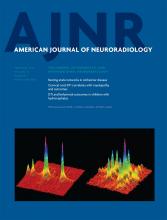Index by author
Lee, C.-W.
- FELLOWS' JOURNAL CLUBNeurointerventionYou have accessProspective Comparison of Angio-Seal versus Manual Compression for Hemostasis after Neurointerventional Procedures under Systemic HeparinizationH.-F. Wong, C.-W. Lee, Y.-L. Chen, Y.-M. Wu, H.-H. Weng, Y.-H. Wang and H.-M. LiuAmerican Journal of Neuroradiology February 2013, 34 (2) 397-401; DOI: https://doi.org/10.3174/ajnr.A3226
This article addresses the utility of Angio-Seal versus manual hemostasis in anticoagulated patients following neurointerventional procedures. In a study of 174 punctures, 104 were closed with Angio-Seal and the rest with manual compression. All patients had activated clotting time values between 250–500 seconds at the time of closure. Mean hemostasis times were significantly longer with manual compression and hematomas 3 times more common. Using Angio-Seal led to arterial occlusion in 1 patient who was successfully revascularized. Thus, Angio-Seal is fast and effective in this setting.
Lehman, V.T.
- FELLOWS' JOURNAL CLUBSpineYou have accessCervical Spine MR Imaging Findings of Patients with Hirayama Disease in North America: A Multisite StudyV.T. Lehman, P.H. Luetmer, E.J. Sorenson, R.E. Carter, V. Gupta, G.P. Fletcher, L.S. Hu and A.L. KotsenasAmerican Journal of Neuroradiology February 2013, 34 (2) 451-456; DOI: https://doi.org/10.3174/ajnr.A3277
The authors sought to determine if Hirayama disease in North America has the same imaging findings as it does in Asia. They assessed imaging studies in 21 patients and looked for loss of attachment of posterior dura, lower cord atrophy and high T2 signal, loss of cervical lordosis, and anterior dural shift in flexion. These 4 findings were able to discriminate patients from healthy controls. MR imaging findings in white North American patients with Hirayama disease include loss of attachment on neutral images and forward displacement of the dura with flexion. Findings are often present on neutral MR images and, in the appropriate clinical scenario, should prompt flexion MR imaging to evaluate anterior dural shift.
Leite, C.C.
- BrainYou have accessReduced Diffusion in Neurocysticercosis: Circumstances of Appearance and Possible Natural History ImplicationsG.T. Santos, C.C. Leite, L.R. Machado, A.M. McKinney and L.T. LucatoAmerican Journal of Neuroradiology February 2013, 34 (2) 310-316; DOI: https://doi.org/10.3174/ajnr.A3198
Leventer, R.J.
- PediatricsOpen AccessBilateral Posterior Periventricular Nodular Heterotopia: A Recognizable Cortical Malformation with a Spectrum of Associated Brain AbnormalitiesS.A. Mandelstam, R.J. Leventer, A. Sandow, G. McGillivray, M. van Kogelenberg, R. Guerrini, S. Robertson, S.F. Berkovic, G.D. Jackson and I.E. SchefferAmerican Journal of Neuroradiology February 2013, 34 (2) 432-438; DOI: https://doi.org/10.3174/ajnr.A3427
Levy, L.M.
- Review ArticlesOpen AccessGABA-Based Evaluation of Neurologic Conditions: MR SpectroscopyL.M. Levy and A.J. DegnanAmerican Journal of Neuroradiology February 2013, 34 (2) 259-265; DOI: https://doi.org/10.3174/ajnr.A2902
Li, R.
- FunctionalOpen AccessAlterations of Directional Connectivity among Resting-State Networks in Alzheimer DiseaseR. Li, X. Wu, K. Chen, A.S. Fleisher, E.M. Reiman and L. YaoAmerican Journal of Neuroradiology February 2013, 34 (2) 340-345; DOI: https://doi.org/10.3174/ajnr.A3197
Li, Y.-X.
- BrainYou have accessMigration: A Notable Feature of Cerebral Sparganosis on Follow-Up MR ImagingY.-X. Li, H. Ramsahye, B. Yin, J. Zhang, D.-Y. Geng and C.-S. ZeeAmerican Journal of Neuroradiology February 2013, 34 (2) 327-333; DOI: https://doi.org/10.3174/ajnr.A3237
Limbrick, D.D.
- PediatricsOpen AccessDiffusion Tensor Imaging Properties and Neurobehavioral Outcomes in Children with HydrocephalusW. Yuan, R.C. McKinstry, J.S. Shimony, M. Altaye, S.K. Powell, J.M. Phillips, D.D. Limbrick, S.K. Holland, B.V. Jones, A. Rajagopal, S. Simpson, D. Mercer and F.T. ManganoAmerican Journal of Neuroradiology February 2013, 34 (2) 439-445; DOI: https://doi.org/10.3174/ajnr.A3218
Lin, J.
- BrainOpen AccessReduced Regional Gray Matter Volume in Patients with Chronic Obstructive Pulmonary Disease: A Voxel-Based Morphometry StudyH. Zhang, X. Wang, J. Lin, Y. Sun, Y. Huang, T. Yang, S. Zheng, M. Fan and J. ZhangAmerican Journal of Neuroradiology February 2013, 34 (2) 334-339; DOI: https://doi.org/10.3174/ajnr.A3235
Liu, H.-M.
- FELLOWS' JOURNAL CLUBNeurointerventionYou have accessProspective Comparison of Angio-Seal versus Manual Compression for Hemostasis after Neurointerventional Procedures under Systemic HeparinizationH.-F. Wong, C.-W. Lee, Y.-L. Chen, Y.-M. Wu, H.-H. Weng, Y.-H. Wang and H.-M. LiuAmerican Journal of Neuroradiology February 2013, 34 (2) 397-401; DOI: https://doi.org/10.3174/ajnr.A3226
This article addresses the utility of Angio-Seal versus manual hemostasis in anticoagulated patients following neurointerventional procedures. In a study of 174 punctures, 104 were closed with Angio-Seal and the rest with manual compression. All patients had activated clotting time values between 250–500 seconds at the time of closure. Mean hemostasis times were significantly longer with manual compression and hematomas 3 times more common. Using Angio-Seal led to arterial occlusion in 1 patient who was successfully revascularized. Thus, Angio-Seal is fast and effective in this setting.








